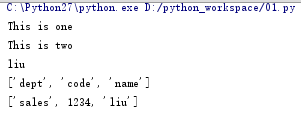Python学习笔记-DAY1
目录
基础加减乘除
变量的使用
字符串输出
字符串的连接
数组的使用
While循环
多行语句表示一行
三重引号可以用于跨越多个行的字符串
Python注释:
需要敲回车结束:
分号( ; ) 允许在单行写入多条语句
多个语句组作为套件:
输入name
元组与列表
字典(通过键值对的形式进行存储)
python 的所有数据类型都是类,可以通过 type() 查看该变量的数据类型:
- Python数据类型转换
总结
基础加减乘除
>>> 17 / 3 # int / int -> int
5
>>> 17 / 3.0 # int / float -> float
5.666666666666667
>>> 17 // 3.0 # explicit floor division discards the fractional part
5.0
>>> 17 % 3 # the % operator returns the remainder of the division
2
>>> 5 * 3 + 2 # result * divisor + remainder
17
>>> 5 ** 2 # 5 squared
25
变量的使用
>>> width = 20
>>> height = 5 * 9
>>> width * height
900
字符串输出
>>> '"Isn\'t," she said.'
'"Isn\'t," she said.'
>>> print '"Isn\'t," she said.'
"Isn't," she said.
>>> s = 'First line.\nSecond line.' # \n means newline
>>> s # without print, \n is included in the output
'First line.\nSecond line.'
>>> print s # with print, \n produces a new line
First line.
Second line.
字符串的连接
>>> # 3 times 'un', followed by 'ium'
>>> 3 * 'un' + 'ium'
'unununium'
>>> 'Py' 'thon'
'Python'
>>> prefix + 'thon'
'Python'
数组的使用
list = [ 'runoob', 786 , 2.23, 'john', 70.2 ]
tinylist = [123, 'john']
print list # 输出完整列表
print list[0] # 输出列表的第一个元素
print list[1:3] # 输出第二个至第三个的元素
print list[2:] # 输出从第三个开始至列表末尾的所有元素
print tinylist * 2 # 输出列表两次
(123, 'john', 123, 'john')
print list + tinylist # 打印组合的列表
>>> word[0:2] # characters from position 0 (included) to 2 (excluded)
'Py'
>>> word[2:5] # characters from position 2 (included) to 5 (excluded)
'tho'
>>> s = 'supercalifragilisticexpialidocious'
>>> len(s)
34
>>> cubes.append(216) # add the cube of 6
>>> cubes.append(7 ** 3) # and the cube of 7
>>> cubes
[1, 8, 27, 64, 125, 216, 343]
>>> letters
['a', 'b', 'C', 'D', 'E', 'f', 'g']
>>> # now remove them
>>> letters[2:5] = []
>>> letters
['a', 'b', 'f', 'g']
>>> a = ['a', 'b', 'c']
>>> n = [1, 2, 3]
>>> x = [a, n]
>>> x
[['a', 'b', 'c'], [1, 2, 3]]
>>> x[0]
['a', 'b', 'c']
>>> x[0][1]
'b'
While循环
... a, b = 0, 1
>>> while b < 10:
... print b
... a, b = b, a+b
...
1
1
2
3
5
8
多行语句表示一行:使用续行字符(\)包含在[],{}或()括号内的陈述并不需要使用续行符
item_one='py'
item_two='th'
item_three='on'
total=item_one +\
item_two+\
item_three
print total
| 1 2 |
days = ['Monday', 'Tuesday', 'Wednesday', 'Thursday', 'Friday'] |
Python接受单引号('),双引号(“)和三(''或”“”)引用,以表示字符串常量,三重引号可以用于跨越多个行的字符串
paragraph="""This is a paragraph. it is
made up of multiple lines and sentences"""
print paragraph
Python注释:
一个井号(#),这不是一个字符串文字开头的注释。“#”号之后字符和到物理行是注释的一部分,Python解释器会忽略它们。
| 1 2 3 |
#!/usr/bin/python # First comment print "Hello, Python!"; # second comment |
这将产生以下结果:
| 1 |
Hello, Python! |
需要敲回车结束:
raw_input("\n\nPress the enter key to exit.")
分号( ; ) 允许在单行写入多条语句
| 1 |
import sys; x = 'foo'; sys.stdout.write(x + '\n') |
多个语句组作为套件:(不需要写括号,只需要同一个块儿的代码缩进相同)
if expression :
suite
elif expression :
suite
else :
suite
输入name
name=raw_input('please input your name')
print'hello,',name
元组与列表
tuple = ( 'runoob', 786 , 2.23, 'john', 70.2 )
list = [ 'runoob', 786 , 2.23, 'john', 70.2 ]
tuple[2] = 1000 # 元组中是非法应用 (元组不允许修改)
list[2] = 1000 # 列表中是合法应用
字典(通过键值对的形式进行存储)
dict={}
dict['one']="This is one"
dict[2]="This is two"
tinydict={'name':'liu','code':1234,'dept':'sales'}
print dict['one']
print dict[2]
print tinydict['name']
print tinydict.keys()
print tinydict.values()
python 的所有数据类型都是类,可以通过 type() 查看该变量的数据类型:
>>> n=1
>>> type(n)
<type 'int'>
>>> n="runoob"
>>> type(n)
<type 'str'>
>>>
a = 111
isinstance(a, int)
True
- type()不会认为子类是一种父类类型。
- isinstance()会认为子类是一种父类类型。
- Python数据类型转换
| int(x [,base]) |
将x转换为一个整数 |
| long(x [,base] ) |
将x转换为一个长整数 |
| float(x) |
将x转换到一个浮点数 |
| complex(real [,imag]) |
创建一个复数 |
| str(x) |
将对象 x 转换为字符串 |
| repr(x) |
将对象 x 转换为表达式字符串 |
| eval(str) |
用来计算在字符串中的有效Python表达式,并返回一个对象 |
| tuple(s) |
将序列 s 转换为一个元组 |
| list(s) |
将序列 s 转换为一个列表 |
| set(s) |
转换为可变集合 |
| dict(d) |
创建一个字典。d 必须是一个序列 (key,value)元组。 |
| frozenset(s) |
转换为不可变集合 |
| chr(x) |
将一个整数转换为一个字符 |
| unichr(x) |
将一个整数转换为Unicode字符 |
| ord(x) |
将一个字符转换为它的整数值 |
| hex(x) |
将一个整数转换为一个十六进制字符串 |
| oct(x) |
将一个整数转换为一个八进制字符串 |
总结:
1. 数据类型 分为数字型和非数字型。
数字型包括整型,长整型,浮点型,复数型;
非数字型包括字符串,列表,元组和字典 ;
非数字型的共同点:都可以使用切片、链接(+)、重复(*)、取值(a[])等相关运算;
非数字型的不同点:
列表 可以直接赋值,元组不可以赋值,字典按照 dict[k]=v 的方式赋值。
2 (1)Numbers(int long float complex (a + bj,或者complex(a,b)表示, 复数的实部a和虚部b都是浮点型))
(2)String
(3)List []
(4)Tuple(元祖)(),相当于只读列表,不可以二次赋值
(5)dictionary(字典){},key值对
3 主提示符 >>>
从属提示符…



